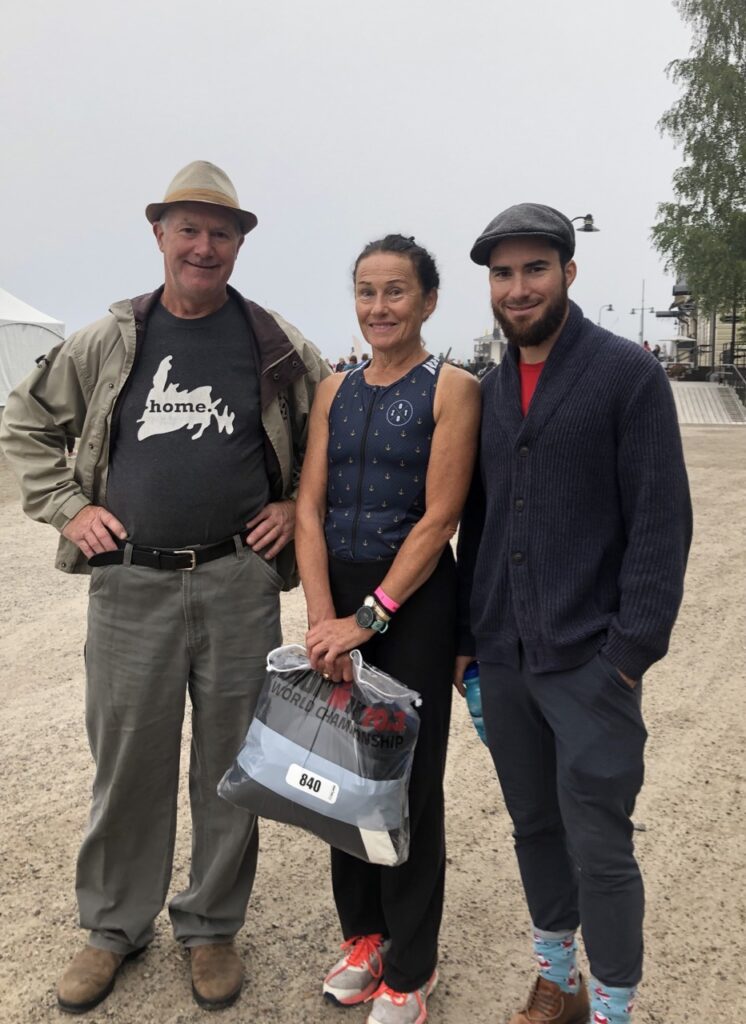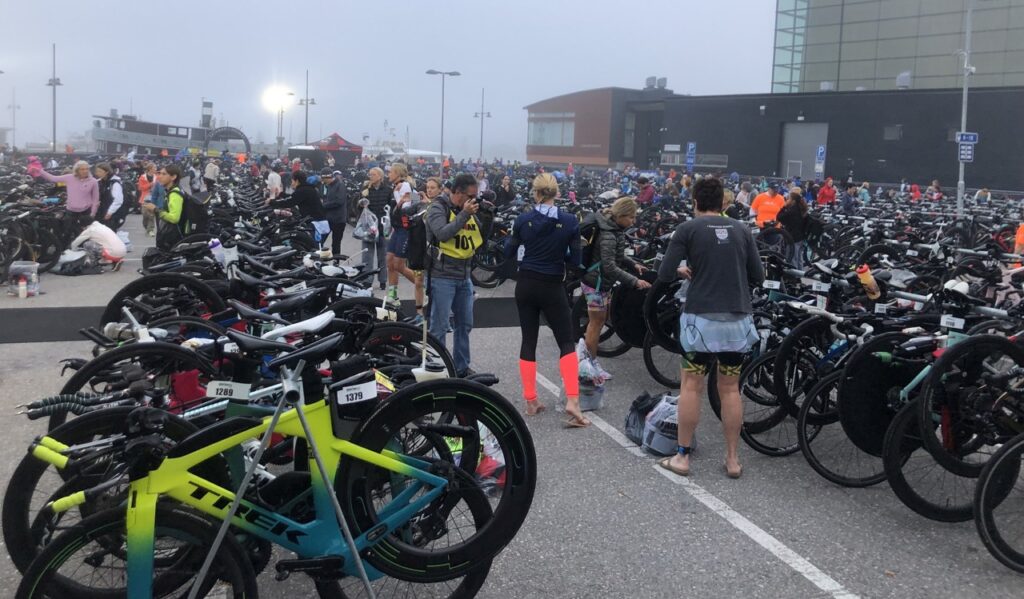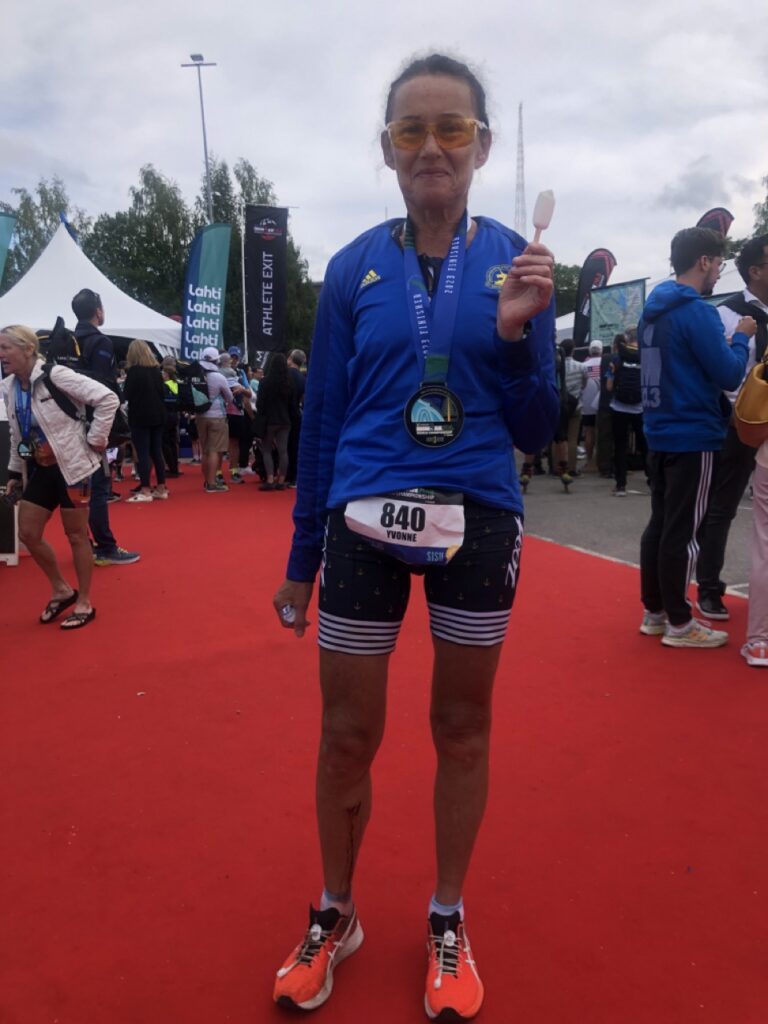An experience like no other: explaining a world championship in Finland
One of Canada's top journalists offers insights from the sidelines in Lahti
 Photo by:
David Gutnick
Photo by:
David Gutnick
“It almost looks like home,” says Les Martin, looking at the fog hanging over Lake Vesijärvi in Lahti, Finland. The fog is so dense you can’t make out the giant yellow and orange buoys that mark the 70.3 world championship swim course, so organizers have pushed back the start by 30 minutes to wait for it to lift.
Les may be standing in the heart of Finland, but he’s making sure folks know where he, his wife Yvonne and son Tom are from: he is wearing a T-shirt emblazoned with a map of Newfoundland and Labrador, with the word “home” right in the middle of his chest.

It’s 6:30 a.m., and Les and Tom are waiting for Yvonne, racing in the 65-69 age category, to finish her final bike check in T1.
Barnacle geese — a sort of miniature Canada goose, but with similar giant poo — are ignoring the crowds, snoozing in gaggles along the shoreline.
Behind us is Lanupuisto Park, an urban forest with 45 species of trees, as neat as a pin, like everything else in Finland.
Les worked as a mechanic on the Hibernia oil platform, three weeks on, three weeks off, for a couple of decades. He retired recently and misses his workmates, but loves how he now has more time to spend working on carpentry projects in his home shop — and to travel.
I ask Les if he’s also a high-level triathlete.
He shakes his head and tells me that Yvonne and Tom are the triathletes — Tom will be racing Sunday in the 35 to 39 age group. Les used to run the 10-mile Tely in St. John’s — one of the oldest road races in Canada — but now prefers other hobbies, like building classic Newfoundland dories.
He spent hundreds of hours building one that he gave to his son and new daughter-in-law as a wedding present. The boat is creamy yellow with Tom and Cassie lovingly hand-painted on the side.
Les looks over to the forest. “You start by cutting your own timber,” he says. “You use the roots for the curved parts, because they are supple and strong.”

Supple and strong like the 6,000 athletes competing in the 70.3 World Championship races this weekend, from as far away as Ghana, Nepal and Kazakhstan.
Yvonne arrives from T1 and says she’s loving Finland, especially the fresh air.
A far cry from her experience just a couple of months ago. On June 25, Yvonne was standing in her wetsuit on the beach of Lac Tremblant, Quebec, smelling the smoke from forest fires hundreds of kilometres north.
The entire sky glowed orange.
Yvonne had been looking forward to testing her legs on the steep hills on Duplessis Road and running over cobblestones through Tremblant village, but says officials were right to call off the race.
“It was disappointing, but it’s all about health, isn’t it?” she says.
Yvonne’s Newfoundland accent is as close to a song as you can get.
“I hope you understand me,” she says with a smile.
“No problem,” I tell her.
To tell you the truth, it is Finnish that’s making my head spin. I can’t tell if the instructions are to pull (vedä) or push (työnnä) doors, how to politely ask for a strong, black coffee (Saanko juoda vahvan mustan kahvin) and how to properly pronounce the name of the small, hot, wood-lined room in almost every Finnish home: Sow (rhymes with cow) nah seems to be as close as I can get.
I did get to a Lahti Pelicans professional hockey (jääkiekko) game. The crowd was largely silent but clapped whenever the Pelican goalie (jääkiekkomaalivahti) made a save. The Pelicans put three kiekkoja in the opponent’s jääkiekkoverkko.
Speaking of silence, the Finnish reputation for being polite, but taciturn to the extreme, seems to be true. It’s been the subject of at least one PhD dissertation, and multiple jokes like this one:
A Swede and a Finn were drinking vodka.
The Swede poured and said, “Skål!”
They drank.
Again the Swede poured and said, “Skål!” And they drank.
A third time, the Swede poured and said Skål,” and they drank.
A fourth time, the Swede poured and said, “Skål!”
The Finn replied, “Are we drinking, or are we talking?”
This magazine isn’t the place to point out the fine points of Finnish baseball — called pesäpallo—but triathletes on their training runs were seen stopping to ask what the heck was going on, as teenagers with bats tossed a ball into the air, slugged it, and then began running in a zig zag between bases.
Pesäpallo has been around for a century, the invention of Lauri “Tahko”(grindstone) Pihkala, who had seen a baseball game when he visited the USA in 1907, fell in love with it and decided to bring it home and redesign it to better suit Finnish sensibilities.
No pitcher, all players are equal.
Go figure.
It might be the key to understanding this social democracy where traffic speeding fines are based on your income.
Suffice to say that like the language, pesäpallo is — as Churchill said of the Russians (true to this day) — “a riddle wrapped in a mystery inside an enigma.”
(Lahti is about an hour-and-a-half car ride from the Russian border. Under the circumstances, still too close, some locals say.)
Back to Yvonne: she was 52nd in her age group out of the water, in 57:14.
Her pedalling up and down the hills around St. Mary’s, NL, proved helpful: the retired teacher passed a dozen women in her age group.
And then, boom! At kilometre 89, just one kilometre from T2, she turned a sharp corner and crashed.
She didn’t take the time to wipe the blood off her scraped right shin and pedalled into transition.
The fog had long since lifted, and the sun was peeking through the clouds when she headed out to run.

Yvonne finished in 7:00:45
27th out of 54.
On Sunday, it’s Tom’s turn to grind out the 70.3.
Yvonne suspects she will be a bit stiff, and she’ll be sporting a few band-aids, but she and Les — he, in that proud Newfoundland T-shirt — will be standing on the shore when Tom dives in.
David Gutnick is an award-winning, now retired CBC documentary producer and avid triathlete from Montreal.
